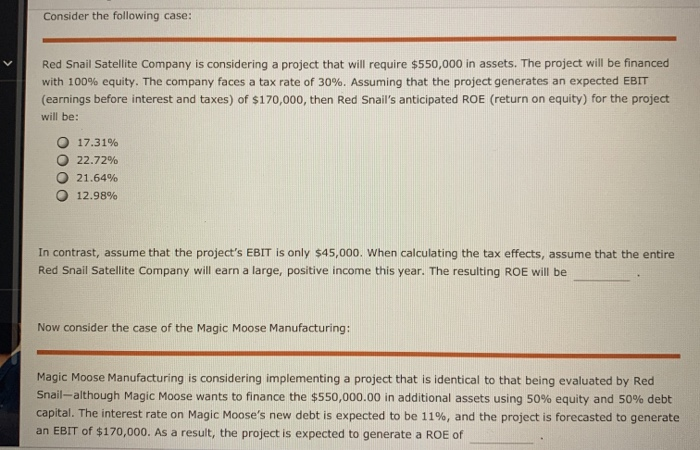Consider the following case: Red Snail Satellite Company is considering a project that will require $550,000 in assets. The project will be financed with 100% equity. The company faces a tax rate of 30%. Assuming that the project generates an expected EBIT (earnings before interest and taxes) of $170,000, then Red Snail's anticipated ROE (return on equity) for the project will be: 17.31% 22.72% 21.64% 12.98% In contrast, assume that the project's EBIT is only $45,000. When calculating the tax effects, assume that the entire Red Snail Satellite Company will earn a large, positive income this year. The resulting ROE will be Now consider the case of the Magic Moose Manufacturing: Magic Moose Manufacturing is considering implementing a project that is identical to that being evaluated by Red Snail-although Magic Moose wants to finance the $550,000.00 in additional assets using 50% equity and 50% debt capital. The interest rate on Magic Moose's new debt is expected to be 11%, and the project is forecasted to generate an EBIT of $170,000. As a result, the project is expected to generate a ROE of Now assume that Magic Moose finances the same project with 50% debt and 50% equity capital, but expects it to generate an EBIT of only $45,000. Further assume that the company as a whole will generate a large, positive income this year, such that any loss generated by the project (with its resulting tax saving) will be offset by the company's other (positive) income. Remember, the interest rate on Magic Moose's debt is 11%. Under these conditions, it is reasonable to expect that Magic Moose will generate a ROE of: 4.94% 4.37% 4.56% 3.8%% Given the ROE-related findings above for both Red Snail and Magic Moose, answer the following question: The use of financial leverage a firm's expected ROE, the probability of a large loss, and consequently the risk borne by the firm's stockholders. The greater a firm's chance of bankruptcy, the its optimal debt ratio will be. manager is more likely to use debt in an effort to boost profits. As a firm takes on more debt, its probability of bankruptcy . Other factors held constant, a firm whose earnings are relatively volatile faces a chance of bankruptcy. Therefore, when other factors are held constant, a firm whose earnings are relatively volatile should use debt capital than a firm whose earnings are more stable. When bankruptcy costs become more important, they the tax benefits of debt. Green Goose Automation Company currently has no debt in its capital structure, but it is considering adding some debt and reducing the percentage of outstanding equity in its capital structure. The firm's current (unlevered) beta is 1.15, and its cost of equity is 12.78. Because the firm has no debt in its capital structure, its weighted average cost of capital (WACC) also equals 12.78. The risk-free rate of interest (rup) is 3%, and the market risk premium (RPM) is 8.5%. Green Goose's marginal tax rate is 30% Green Goose is examining how different levels of debt will affect its costs of debt and equity, as well as its WACC. The firm has collected the financial information that follows to analyze its WACC. Complete the following table. D/A E/A Bond Before-Tax Levered Cost of Ratio Ratio D/E Ratio Rating Cost of Debt Beta (b) Equity (rs) WACC 12.78% 12.78% 0.2 0.8 0.25 A 14.48% 12.72% 0.67 8.50% 1.69 17.37% 0.6 1.50 BB 10.90% 2.36 13.80% 0.2 4.37 40.15% 1.15 0.0 0.00 1.0 8.10% 0.4 BBB 0.6 0.4 0.8 13.909









